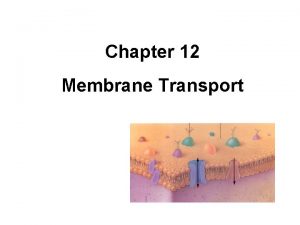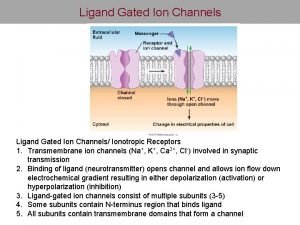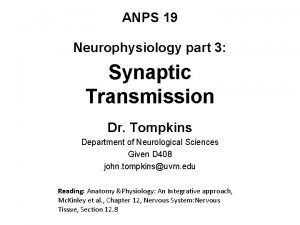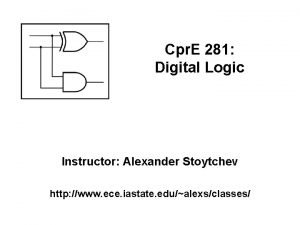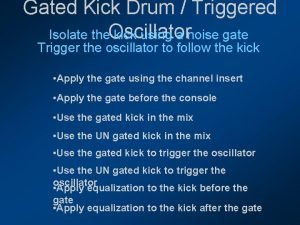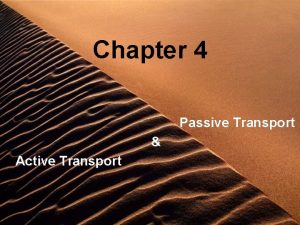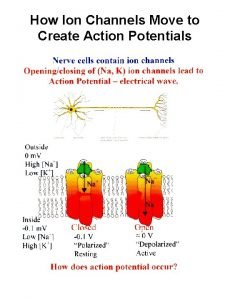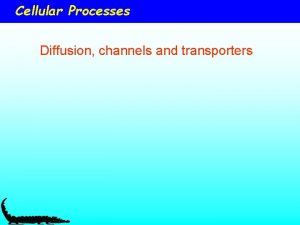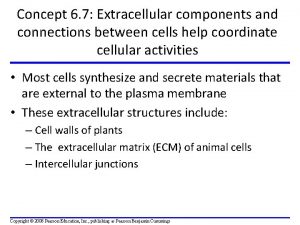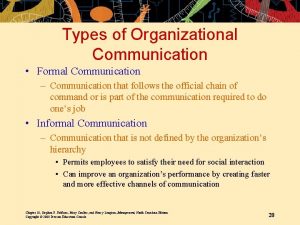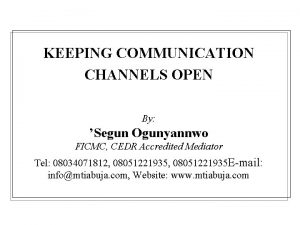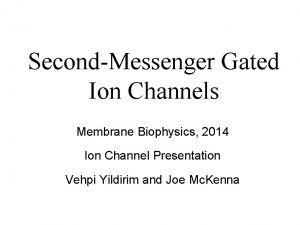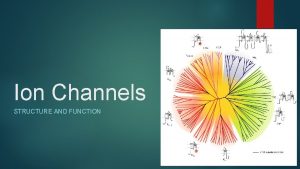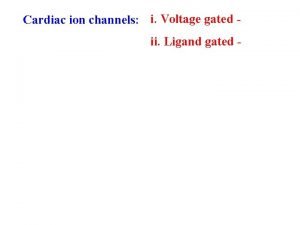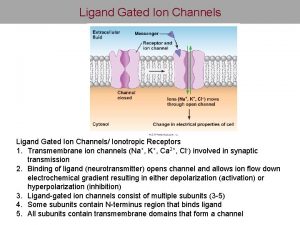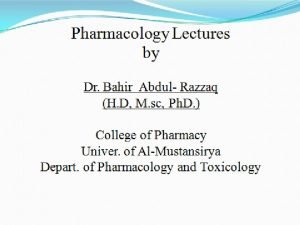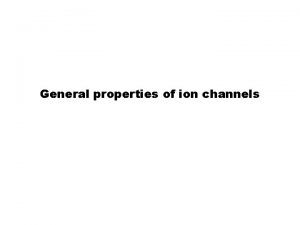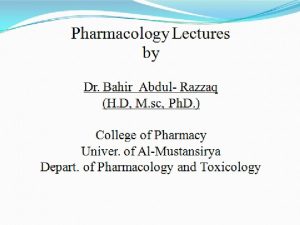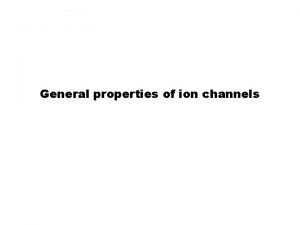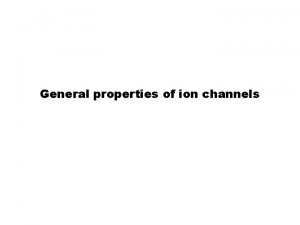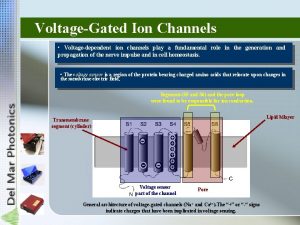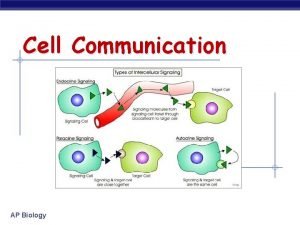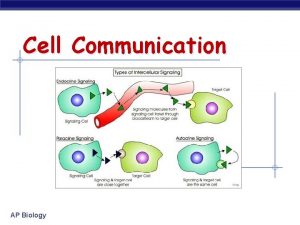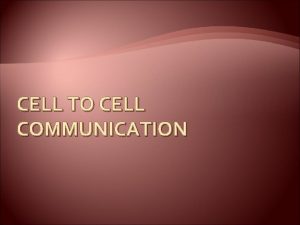Gated Channels Cell Communication Ion channels Ion channels


























- Slides: 26

Gated Channels & Cell Communication

Ion channels • Ion channels are pore-forming membrane proteins that allow ions to pass through the channel pore. • Their functions include gating the flow of ions across the cell membrane, controlling the flow of ions across secretory and epithelial cells, and regulating cell volume. • Ion channels are present in the membranes of all cells. • Ion channels are one of the two classes of ionophoric proteins, along with ion transporters.

• The study of ion channels often involves biophysics, electrophysiology, and pharmacology, while using techniques including voltage clamp, patch clamp, immunohistochemistry, X-ray crystallography, fluoroscopy, and RT-PCR. • Their classification as molecules is referred to as channelomics.

• There are two distinctive features of ion channels that differentiate them from other types of ion transporter proteins: • The rate of ion transport through the channel is very high (often 106 ions per second or greater). • Ions pass through channels down their electrochemical gradient, which is a function of ion concentration and membrane potential, "downhill", without the input (or help) of metabolic energy

Biological Roles � • Conductance of Nerve impulse, generation of action potential, synaptic transmission. � • Cardiac, skeletal and smooth muscle contraction. • Epithelial transport of nutrients and ions. � • T-cell activation (immune regulation). � � • Pancreatic beta cell insulin release.

Gating Channels • Ion channels may be classified by gating, i. e. what opens and closes the channels. • 2 Types: • Voltage Gated • Ligand Gated • Voltage-gated ion channels open or close depending on the voltage gradient across the plasma membrane. • While ligand-gated ion channels open or close depending on binding of ligands to the channel.

Voltage Gated • Voltage sensitive • Conformational change in response to the potential gradient. • Generally ion specific. • Important for excitable cells like neurons. • Distributed along the axon and soma of the neurons.

Types of Voltage Gated Channels Voltage Gated Sodium Channels • � �

Transient receptor potential channels (TRP channels): • 28 types, some of them are voltage gated, named after their role. Present in Drosophila phototransduction. Hyperpolarization-activated cyclic nucleotide-gated channel • pacemaking channels in the heart, sensitive to c. AMP, c. GMP that alter the voltage sensitivity of the channels. Voltage • helps regulated. sensitive in acid proton channels extrusion from cell, phagocytosis, strongly p. H

Structure • Several subunits with a central pore. • Ion specific, but ions with similar charge and size can enter. • Functionality governed by 3 main parts- the voltage sensor, the pore and the gate. • Na, K and Ca channels have 4 transmembrane alpha subunits surrounding the pore. • Six subunits: S 1 -S 6. • S 1 -S 4: Voltage sensing region, S 5 -S 6: Gate and pore. • Regulatory beta subunits.


Mechanism of Action

Mechanism • For potassium channel: •

Voltage sensing in Na and Ca channels: • Positive charges in the voltage sensing domain, presence of Arginine and histidine repeats in this segment. • Gate acts as a mechanical obstruction to ion flow. • Channel closes milliseconds after opening.

Ligand Gated Channels • Group of transmembrane ion channels that allow the passing of several ions upon the binding of specific chemical messenger like neurotransmitters. • Two Domains – transmembrane domains including channel pore, Extracellular domain including ligand binding site. • Function: Conversion of presynaptic chemical signal quickly and effectively into post-synaptic electrical signal. • Three super families: Receptor, ATP Gated Channels cys-loop receptors , Ionotropic Glutamate

Cys-loop receptors • Characteristic loop formed by a disulfide bond between two cysteine residues in the N terminal extracellular domain. • Provides specificity for • Acetyl Choline, Seratonin, Glycine, Glutatamate, γ-aminobutyric acid • Structural elements are well conserved with a extracellular domain (ECD) harbouring an alpha-helix and 10 beta strands • Following the ECD four transmembrane segments (TMSs) are present.

Ionotropic Glutamate Receptor • Binds to Glutamate. • Consists of a tetramer. • Each sub-unit consists of extracellular amino terminal domain (ATD) which is involved in tetramer assembly, an extracellular ligand binding domain LBD, which binds glutamate, and a transmembrane domain TMD, which forms the ion channel. •

ATP Gated channels • Bind to ATP in order to open. • They form trimers with two transmembrane helices per subunit and both the C and N termini on the intracellular side.

Mechanism and Receptors �

Cell communication • Cell signaling is part of any communication process that governs basic activities of cells and coordinates all cell actions. • The ability of cells to perceive and correctly respond to their microenvironment is the basis of development, tissue repair, and immunity, as well as normal tissue homeostasis. • Errors in signaling interactions and cellular information processing are responsible for diseases such as cancer, autoimmunity, and diabetes. • By understanding cell signaling, diseases may be treated more effectively and, theoretically, artificial tissues may be created.

Form of Signaling • Cells communicate via various types of signaling that allow chemicals to travel to target sites in order to elicit a response. • Paracrine signaling occurs between local cells where the signals elicit quick responses and last only a short amount of time due to the degradation of the paracrine ligands. • Endocrine signaling occurs between distant cells and is mediated by hormones released from specific endocrine cells that travel to target cells, producing a slower, long-lasting response. • Autocrine signals are produced by signaling cells that can also bind to the ligand that is released, which means the signaling cell and the target cell can be the same or a similar cell. • Direct signaling can occur by transferring signaling molecules across gap junctions between neighboring cells.

Types of Molecules • Intracellular receptors are located in the cytoplasm of the cell and are activated by hydrophobic ligand molecules that can pass through the plasma membrane. • Cell-surface receptors bind to an external ligand molecule and convert an extracellular signal into an intracellular signal. • Three general categories of cell-surface receptors include: ion -channel, Gprotein, and enzyme -linked protein receptors. • Ion channel -linked receptors bind a ligand open a channel through the membrane that allows specific ions to pass through. • G-protein-linked receptors bind a ligand activate a membrane protein called a G-protein, which then interacts with either an ion channel or an enzyme in the membrane. • Enzyme-linked receptors are cell-surface receptors with intracellular domains that are associated with an enzyme.

Signaling Molecules • Produced by signaling cells and the subsequent binding to receptors in target cells, ligands act as chemical signals that travel to the target cells to coordinate responses. • The types of molecules that serve as ligands are incredibly varied and range from small proteins to small ions like calcium (Ca 2+). • Small Hydrophobic ligands • Water Soluble ligands • Other Ligands

Small Hydrophobic ligands • Small hydrophobic ligands can directly diffuse through the plasma membrane and interact with internal receptors. • Important members of this class of ligands are the steroid hormones. • Steroids are lipids that have a hydrocarbon skeleton with four fused rings; different steroids have different functional groups attached to the carbon skeleton. • Steroid hormones include the female sex hormone, estradiol, which is a type of estrogen; the male sex hormone, testosterone; and cholesterol, which is an important structural component of biological membranes and a precursor of steriod hormones. • Other hydrophobic hormones include thyroid hormones and vitamin D. • In order to be soluble in blood, hydrophobic ligands must bind to carrier proteins while they are being transported through the bloodstream.

Water-soluble ligands • Water-soluble ligands are polar and, therefore, cannot pass through the plasma membrane unaided; sometimes, they are too large to pass through the membrane at all. • Most water-soluble ligands bind to the extracellular domain of cell surface receptors. • The binding of these ligands to these receptors results in a series of cellular changes. • These water soluble ligands are quite diverse and include small molecules, peptides, and proteins.

Other Ligands • Nitric oxide (NO) is a gas that also acts as a ligand. • It is able to diffuse directly across the plasma membrane; one of its roles is to interact with receptors in smooth muscle and induce relaxation of the tissue. • NO has a very short half-life; therefore, it only functions over short distances. • Nitroglycerin, a treatment for heart disease, acts by triggering the release of NO, which causes blood vessels to dilate (expand), thus restoring blood flow to the heart.
 What causes hyperpolarization
What causes hyperpolarization Transmembrane ligand gated ion channel
Transmembrane ligand gated ion channel Distribution of gated channels on a neuron
Distribution of gated channels on a neuron Rnn andrew ng
Rnn andrew ng Difference between flip flop and latch
Difference between flip flop and latch Gated d-latch
Gated d-latch Accordion hose load
Accordion hose load Gated oscillator
Gated oscillator Inverse gated decoupling
Inverse gated decoupling Ion channel
Ion channel In primitive flow table for gated latch each state has
In primitive flow table for gated latch each state has Gate
Gate Function of voltage gated sodium channel
Function of voltage gated sodium channel T flip flop excitation table
T flip flop excitation table Ete
Ete Teardowns definition ap human geography
Teardowns definition ap human geography Are ion channels passive or active
Are ion channels passive or active Ion channels
Ion channels Is symport secondary active transport
Is symport secondary active transport Ion dipolo
Ion dipolo Fuerzas dipolo dipolo ejemplos
Fuerzas dipolo dipolo ejemplos Fuerzas de london
Fuerzas de london Intermolecular forces on vapor pressure
Intermolecular forces on vapor pressure Channels that perforate plant cell walls
Channels that perforate plant cell walls Formal channels of communication
Formal channels of communication Communication channels in sales promotion
Communication channels in sales promotion Keep communication channels open meaning
Keep communication channels open meaning
